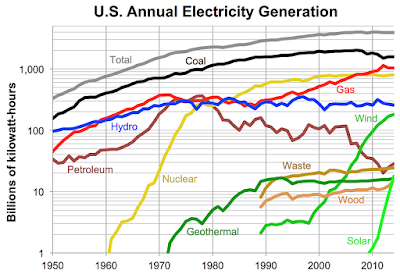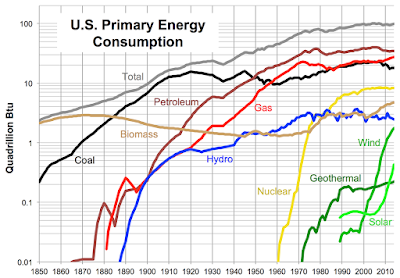I just read a fascinating article on the so-called “war on coal” that has shut down a significant fraction of U.S. coal-fired power plants over the last several years. What was almost unthinkable just a few years ago has become a reality, thanks to a confluence of technology (shale gas extraction, wind power, and efficiency), economics (the great recession), government regulations (thanks, Obama!), and environmental activism (the Sierra Club’s “Beyond Coal” campaign, funded by Michael Bloomberg).
The article is accompanied by a graph that shows all the sources of U.S. electricity over the last 30 years, highlighting the dramatic (roughly 20%) decline of coal since 2007—even while coal remains larger than any other electricity source.
I love graphs like that, but I wanted a longer-term perspective and I also wanted to visualize the data a little differently. So I pulled the data from the EIA web site and plotted it up as a stacked area chart, going back to 1950:
The recent decline of coal is all the more striking when juxtaposed with its remarkably steady rise over more than 50 years. Though if you look closely, you’ll see that the rise had already flattened out before 2007.
The advantage of the stacked area chart is that it also shows the total electricity generation at a glance—and the behavior of the total is also striking. After an almost uninterrupted rise from 1950 through 2007 (with just a couple of hiccups due to the oil price spikes of the 70s and early 80s), U.S. electricity generation (and consumption) stopped growing in 2008. Even though our economy has recovered in most respects since 2009, our electricity use hasn’t quite regained its pre-recession peak. I won’t try to predict whether it will do so in the coming years.
Meanwhile, there’s so much more to notice on that graph. Look at the rise and fall of petroleum as an electricity source. Marvel at the rapid rise of nuclear power and how steady it has remained in recent decades. And don’t overlook that expanding sliver of green at the top, which now comes mostly from wind energy (4.5% of total U.S. electricity in 2014).
To get a better view of wind energy and the other minor contributors, here I’ve plotted the same data on a logarithmic scale (with no stacking):
On this graph, a straight, upward-sloping line corresponds to exponential growth (a fixed percentage increase each year). It’s interesting to look at how each electricity source has experienced a period of approximately exponential growth at some time in the past, but these periods always end when that growth runs up against practical limits. The exponential growth of wind has recently slowed, but now solar-generated electricity is in a period of dramatic exponential growth. Let’s hope this period lasts a little longer!
I find it remarkable, though, that the log-scale graph of total U.S. electricity generation is almost entirely concave-down. The very rapid exponential growth of the early 1950s slowed somewhat in the 60s, then slowed a lot more after 1973, then slowed to a crawl after 2000, and has now more or less stopped.
Of course, electricity isn’t the same as energy. For a bigger-picture view we should also include fuels used for heating and transportation and industrial machinery. The energy sources used for all these things, including electricity generation, are called “primary” energy, and EIA actually has estimates of primary energy use, by source, going back to the founding of the American colonies. For the first 200 years the only important source (besides muscle power, which EIA doesn’t count) was wood. I’ve started the following graph in 1850, when coal makes its first appearance:
The units on this graph are quadrillions of British thermal units, or “quads” for short. One quad equals 293 billion kilowatt-hours, but the inherent inefficiency of heat engines means that a quad can generate only about 100 billion kWh of electricity. Roughly, therefore, the current annual total of about 4000 billion kWh on the electricity graphs requires about 40 quads of primary energy. The other 60 or so quads of primary energy go toward transportation, heating, and industry. (To see a careful breakdown of how each of these energy sources is used, look at the latest energy flow chart from Lawrence Livermore National Lab.)
(A couple of technical notes on the primary energy data: First, the numbers from before 1949 are estimated from various sources and are provided by EIA at only 5-year intervals, so there could be important details that are missing. Second, for non-thermal electricity sources like hydro, wind, and photovoltaic solar cells, EIA defines the “primary” energy to be the amount of some other fuel that would produce (on average) the same amount of electricity. This fictitious accounting allows for fair comparisons between thermal and non-thermal electricity sources.)
Looking at the graph above, notice that coal provided more than half of all U.S. energy from about 1885 through 1940. During that era our cities were badly polluted with soot. My own house, built in 1935, was originally heated with coal; the coal room in the basement now stores assorted outdoor equipment and other hardware. Nowadays, coal burning occurs almost exclusively at electric power plants, mostly outside major cities.
Again it’s also useful to plot the same data on a logarithmic scale, with no stacking:
Here you can see the early growth of each major energy source in detail, notice how they were affected by the Great Depression and the 1970s, and mentally extrapolate to the right to envision a variety of possible energy futures. Petroleum remains our largest single energy source, a distinction it has held since 1950. Biomass is making a bit of a comeback, thanks mostly to ethanol added to motor fuels. Wind and solar are tiny in comparison to the fossil fuels, but their extremely rapid growth is encouraging. The recent flattening of total energy use is even more apparent than for electricity alone, extending back to the late 1990s when all forms of energy are included.
For an even bigger picture I should really plot energy use for the entire world, rather than just the United States. One of the best sources of worldwide energy data is the BP Statistical Review of World Energy. The data in the BP Review goes back only to 1989, but at least it gives the big picture since then.
According to the BP Review, Europe’s coal use was on the decline already in 1989, though it has been fairly stable in recent years. Far outweighing the declines in Europe and the U.S., however, has been the phenomenal increase of coal use in China, especially during the 2000s. China now uses approximately half of the world’s coal, and its per-capita use is now about the same as in the U.S. (although its per-capita use of petroleum and natural gas are much less than ours). Even China’s use of coal, however, was fairly stable for the last couple of years and now seems to be decreasing. And it should be pointed out that a significant fraction of energy use in the developing world goes toward manufacturing products for export to wealthier countries. The coal used to make your iPhone is not included in the graphs on this page.
Wednesday, July 15, 2015
Subscribe to:
Posts (Atom)





